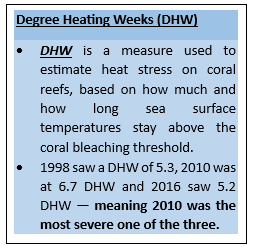Syllabus:
GS1: Important Geophysical phenomena such as earthquakes, Tsunami, Volcanic activity, cyclone etc., geographical features and their location- changes in critical geographical features (including water bodies and ice-caps) and in flora and fauna and the effects of such changes.
Context:
The 24-year-long study shows that corals in the Lakshadweep archipelago have declined to 50% of what they were in 1998.
More on the News

- The study was published in Diversity and Distributions by researchers from across India and Spain.
- It uses long-term data to propose a model for identifying both vulnerable and potentially resilient reefs.
- The Union Territory of Lakshadweep Archipelago consists of 12 coral atolls. Using data from 12 reef sites across three of them, Agatti, Kadmat and Kavaratti, the team tracked coral health from 1998 to 2022.
- Coral cover in Lakshadweep declined by 50% over 24 years, from 37.2% in 1998 to 19.1% in 2022.
- Coral mortality decreased over successive bleaching events, but the overall ability of reefs to recover has also declined.
- Recovery of coral cover was non-linear and accelerated only after 6+ years without bleaching.
- The study provides a predictive framework for reef management, but stresses that global climate action is essential.
- Lakshadweep experienced three marine heatwaves in 1998, 2010, and 2016, mainly driven by El Nino phases, which raised sea temperatures and caused coral bleaching.
- One of the study’s most striking findings is that coral recovery accelerates only after a six-year gap between bleaching events.
- Shorter recovery windows, like the one between 2010 and 2016, limit the ability of fast-growing coral genera such as Acropora to bounce back.
- Researcher warned that even the most resilient reef communities cannot withstand increasingly frequent heatwaves indefinitely.
- The study provides a predictive tool to guide conservation in Lakshadweep, helping prioritize reef areas for protection and recovery in the absence of formal management.
Reasons for Coral Depletion
- Climate phenomenon El Nino Southern Oscillation events, particularly El Nino phases, contribute to coral bleaching due to increased sea surface temperatures.
- Storm-driven rainfall can quickly dilute ocean water, leading to bleaching of near-shore corals.
- Wave exposure and depth affect reef resilience and coral response to climate stress.
Importance of Corals
- Coral reefs are home to an estimated 25% of all marine life, including over 4,000 species of fish. They provide food and shelter for a wide variety of organisms.
- Act as a natural barriers, shielding coastlines from erosion, storms, and tsunamis.
- Reefs can play a role in absorbing carbon dioxide from the atmosphere, though this is still being researched.


